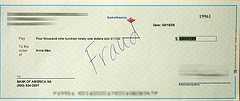
There are a record amount of counterfeit cashier's checks, official checks, money orders, travelers and gift cheques in circulation. This is an attempt to pass on information that the average person can use to tell IF the item is real or a counterfeit (fake).
As a disclaimer -- this is only a guide and if you deposit or cash items from people you don't know -- you do so at your own risk. The quality of these items is getting better all the time.
I’ve put together a list of the known counterfeit items in circulation, along with the current telephone numbers to verify them. You will probably receive these items after being lured with a (too good to be true) get rich quick scheme that doesn't make very much sense.
The best method to verify an item is to go to the maker, or issuer of the check (cheque). They probably will know if they issued it. The key here is to make sure you are speaking with the real issuer (maker) of the item.
Never trust a number provided on the instrument, fake telephone numbers are sometimes set up that will even verify in 411 (information).
Simply stated, as long as the communication companies think they are being paid, setting up a fake number is no problem. We are seeing fake numbers set up by scammers pretty frequently.
Since these numbers are often set up in 411 (information) rather easily, I recommend using Phonevalidator.com. This site provides a service that shows if a number belongs to a cell, or a land line. It also provides telephone directory and Google results for the number queried.
Quite often, fake numbers set-up to verify checks are cell phones.
The Internet is a good way to find the true issuer (maker) of an item. The key is to make sure you are visiting a legitimate site.
Fake websites (especially those pretending to be financial institutions) are a growing problem, also. An easy way to check if a site is legitimate is by using TrustWatch, which verifies whether a site is known (trusted) or not.
If you are interested in taking a look at some fake sites, claiming to be financial institutions the Artists Against 419 has some great examples of them on their site.
A common denominator in most of the scams is that there will be a request to send the proceeds, minus your paltry cut (normally via wire transfer) back to the person sending you the instruments. That is (unless) they are buying goods from you. In this case, your property is what they want you to send to them.
Some of these lures include, but aren't limited to (new lures surface frequently), secret shopper, romance, lottery, work-at-home and auction scams.
The National Consumers League recently set up a site (fakechecks.org), which is a great reference on Internet scams involving checks (complete with visual presentations), here.
So far as auction scams, eBay will no longer offer any protection for paper financial instruments on their site.
Here are some of the known items being counterfeited in large quantities and literally circulating worldwide:
Visa Travelers Cheques: 1-800-227-6811.
MoneyGram Money Orders (counterfeits may still use the old Travelers Express logo): 1-800-542-3590.
US Postal Money Orders: 1-877-876-2455 (mail fraud) option 4, then go to option 2.
American Express Gift and Travelers Cheques: 1-800-221-7282.
FDIC Alerts on the counterfeit cashier's and official checks in circulation, here. There is a feature that allows you to search them. I would try it by using the name of the institution.
Counterfeit cashier's and official checks change almost daily. The counterfeiters use legitimate account numbers and convincing looking check stock that will verify in most automated telephone verification systems.
It's probably good advice to never trust an automated system. In the case of a counterfeit, real ABA/account numbers are used by the counterfeiters. Because the information is real, they get past an automated verification system fairly easily. If you really want to know and believe an item is a counterfeit, ask to speak to a live person, preferably in the fraud department.
If you are dealing with a suspected counterfeit cashier's, or official check, I highly recommend reading a post I collaborated on with Tom Fragala (CEO of Truston Identity Theft Protection Services):
Counterfeit Cashier's Checks Fuel Internet Crime
Bank employees sometimes verify counterfeit instruments as legitimate. In some instances, especially at a teller window, they have been mistaken. If this occurs, you will be notified days later and the bank will take no responsibility.
Even more alarming, I have talked to and get comments/e-mails from people all the time who are getting arrested after trying to negotiate these items.
Here is what I wrote about this growing phenomenon in a previous post, along with my personal speculation as to why this is happening more frequently:
When the check is discovered to be fraudulent, anywhere from right on the spot to about ten days later the person passing the item is left holding the bag. This can translate into a loss of their freedom (getting arrested), being held financially liable, or a combination of both these consequences.
A new trend has been noted called reverse-scamming, also. This occurs when scammers have the bogus instruments sent to them, cash them and then never follow the instructions to wire the money.
If confronted, these reverse scammers will normally claim to be victims. A key way to pick out a reverse scammer is that, in most instances they forget to wire the money back to the scammer that sent them the counterfeit instrument.

